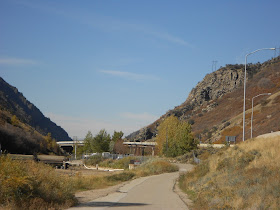An alcove, all that's left of Devil's Gate today in Weber Canyon, Photo by Whitney Arave
THE bugaboo
of Devil’s Gate in lower Weber Canyon plagued travelers for well over a
century.
The single
geological feature of Devil’s Gate is what detoured the 1847 Mormon Pioneers
through Emigration Canyon, instead of lower Weber Canyon.
Narrow,
curvy and sometimes called “Scrambled Egg Curve” in the mid-20th
Century for all the overturned trucks, it wasn’t until the freeway came along
that the “Devil” was finally conquered.
In 1966, the
freeway finally opened through Devils Gate and Weber Canyon. That section of
freeway in the lower canyon cost $3.5 million. 1 million cubic yards of
material were removed from Peterson to Gateway in Weber Canyon.
The Standard-Examiner
of May 22, 1964 stated there were great advantages to eliminating the horseshoe
bend at Devil’s Gate.
The I-84 freeway bridge span, east of Devil's Gate today.
“A huge
overpass at the Devil’s Gate curve was built over the Union Pacific tracks in
order to eliminate the treacherous curve,” the Standard of Feb. 26, 1965
reported.
“The river,
railroad and highway squeak through the practically vertical cliffs at Devil’s
Gate,” the Salt Lake Tribune of May 26, 1965 reported.
All 63 miles
of freeway, I-80, from Uintah to Wyoming were open by late 1967.
Truckers during the Weber Canyon freeway construction process were told to keep their windows shut and use the air conditioning -- no matter what. That's because there were sometimes rattlesnakes lurking in the debris they were hauling away and more than one truck driver got spooked when a rattler crawled to the cab and stuck his head inside the window!
(Note: There is at least one other "Devils Gate" in Utah. There is another feature with the name found in the extreme northwest corner of the state, in the Grouse Creek area.)
Truckers during the Weber Canyon freeway construction process were told to keep their windows shut and use the air conditioning -- no matter what. That's because there were sometimes rattlesnakes lurking in the debris they were hauling away and more than one truck driver got spooked when a rattler crawled to the cab and stuck his head inside the window!
(Note: There is at least one other "Devils Gate" in Utah. There is another feature with the name found in the extreme northwest corner of the state, in the Grouse Creek area.)
More historical
tidbits:
-“Fined for
riding on the sidewalks” was a July 6, 1917 headline in the Standard.
Back then,
violators to Ogden City ordinance who rode their bicycles on city sidewalks
were fined $2.
“It is the
aim of the court to break up this practice as soon as possible and every person
found riding on the sidewalk will be brought to court,” the story stated.
According to
the Standard on April 5, 1910, all sidewalks were then made off limits to
bikes, not just certain ones. This law also included motorcycles and even
tricycles. Motorcycles were also henceforth required to carry a gong and
headlight, to warn others of their approach.
And, the
same law meant that cafes and saloons then had to be separate – without
connecting doors – or face closure. Each café-saloon had two weeks time to
remodel, or lose their saloon license.
-The same
1917 story also reported that a man was fined $5 for driving at a reckless
speed in his Ford delivery truck, with nine girls as passengers.
-Bicycles
had been a controversial form of travel, even in late 19th Century
Ogden. “License the bicycle” was a Feb. 7, 1897 editorial in the Standard.
At that
time, some 1,000 bicycles (“wheels”) were estimated to exist in Ogden and for a
proposed $1 a year license, many road improvements could be done.
-“Kept pigs
near his home and is arrested” was a June 1, 1915 Standard headline.
The owner of
a fruit and commission store at 2227 Washington Avenue pleaded guilty to charge
of maintaining a nuisance – having a number of pigs at the rear of his
property. The Italian man said he never intended to keep the pigs long, but a
prospective sale of the swine had fallen through.
(-Originally published on-line and in print in the Ogden Standard-Examiner on June 25-26 by Lynn Arave.)
-NOTE: The
author, Lynn Arave, is available to speak to groups, clubs, classes or other organizations
about Utah history at no charge. He can be contacted by email at:
lynnarave@comcast.net












